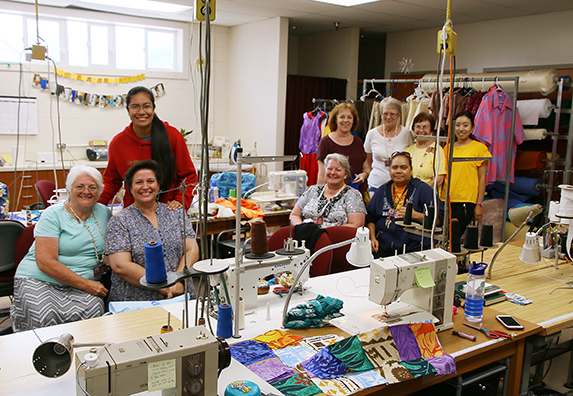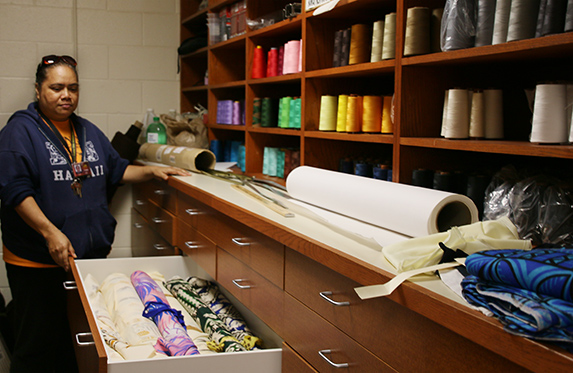Creating thousands of costumes and uniforms
Most Polynesian Cultural Center visitors probably don’t realize that behind the scenes over a dozen dedicated ladies create thousands of beautiful costumes and unique uniforms for our employees and replace them from time to time.
The hard-working seamstress team works out of an air-conditioned room near the PCC’s back gate. They currently consists of two full-time employees, Seamstress Department supervisor Fatai Feinga and her assistant Elizza Keni, plus nine full-time volunteers, and two part-time student workers.

PCC seamstresses in their compact work area. (PCC photos by Mike Foley)
“Our workload is big, but we can handle it with the help of our senior missionary ladies,” Fatai said. “We sew the island uniforms and show costumes. For the costumes, we work hand-in-hand with Cathy Teri’ipaia, the daughter of Elisa Teripa’ia who was my supervisor when I started here almost 30 years ago. I was blessed to have learned about the show costumes from her and Aunty Nona Warner, who retired six years ago. Cathy’s team also makes all the handcrafted costumes, such as Tahitian skirts and others that use shells.”
“We’re also responsible for all the other PCC uniforms, except for the guides and food and beverage people — and we previously used to do those, too.”
Skilled senior missionary volunteers make a big impact
She said the full-time senior volunteers “make a big impact when they come. Not only do they already know how to sew, but they are all hard workers and bring a willing spirit. We’re so blessed to have them here.”
“When our students first apply and are accepted, they usually don’t know how to sew, so we teach them. By the time they leave, they’re professionals. Some of the former students I’m in touch with still do seamstress work back home and have actually started their own businesses.”
Routines and getting ready for a major new production
Typically, Fatai said other PCC departments submit orders. “For example, the items we make the most are the sulu or skirt-like lavalava [wrap-around sarong] that many male PCC employees wear at work. Our two student workers usually put those together. Normal orders for them usually ask for 10 or 12 at a time, but that number can grow to as many as 50 at a time, in all sizes, when departments order at the same time.”
She also pointed out, “Our ladies create a lot of the aloha-wear uniforms for some of the other senior missionary volunteers, who all usually serve for 12-24 months, and turn over regularly. I’m already mentally preparing myself for when five of our ladies go home this June and July.”
Then there are the theater costumes, which require a lot of extra efforts from the PCC seamstresses when new productions are in rehearsal. “Most recently, we’ve been busy preparing costumes for the Center’s upcoming new production, Huki — a celebration of Polynesian legends and heroes on the lagoon every afternoon. That’s been a big undertaking.”
“So far, we’ve made almost 600 ‘pieces’ for Huki, like a lavalava or a top, and we’re about half-way done,” she said. “I’ve previously worked on five new shows, but this is the biggest one costume-wise. I’m excited for it to premiere this summer.”
Professional equipment and layout speed up production
“To accomplish all of this, we have good equipment,” Fatai said. “PCC seamstresses use industrial sewing machines because their speed helps us produce faster. Some of our machines are over 15 years old, and we service them regularly. We also have several commercial home-style sewing machines, which some of our people are more comfortable with, but they’re slower.”
“We use pattern templates to cut all the material pieces and industrial sergers, which trim any extra material on the cut pieces and overcast the edges to prevent fraying, but still allow the seams to stretch a little. Otherwise, they would tear.” She explained sergers use up to six large “cones” of thread, while smaller sergers, also known as baby-locks, do the same thing but use fewer cones.

Supervisor Fatai Feinga shows how compact the Seamstress’ notions room is. The specially designed drawers hold dozens of bolts of material.
One might imagine all that output would require a lot of space, but the seamstress workroom in the PCC employee building is deceptively small. “We have special drawers in the notions room to store all of the bolts of material we use,” Fatai said, adding she was involved in making sure the PCC physical facilities staff created drawers in the notions room that could accommodate bolts of material. “They are usually 45-inches wide and 60 yards long, although there are also larger bolts. We have special racks for those.”
“And storage space is not a problem,” she continued. “When we’re done, we email the various department managers and tell them to come pick up their orders.”
Recycling and replacing uniforms and costumes
“Depending on the work assignment, the PCC usually provides most employees with two uniforms — wear one, wash one — but some areas need four, depending on standards,” Fatai continued. “These employees are also expected to wash and care for their uniforms at home; and when they need renewing, their managers put in a new order. Our island costumes, because they’re usually outside, for example, may need replacing in two years. PCC show costumes usually last approximately four years, because we use different fabrics for them, so they tend to last longer.”
“When employees leave the Center, their uniforms and costumes are reused, if possible,” she added.
PCC seamstresses love their work
Anyone entering the seamstress workroom can feel there’s something special going on there, and we’re not just talking about sewing. In addition to logistics, the seamstresses put a lot of aloha into making our beautiful Polynesian Cultural Center uniforms and costumes, and guests often tell us they enjoy this.
“We have a real ‘ohana [family] here, and we enjoy what we do,” Fatai said. “Working with the seamstresses all these years has made me the person I am today, and I’m still learning new things and ideas from the others. I love this place.”
 Story and photos by Mike Foley, who has been a full-time freelance writer and digital media specialist since 2002. Prior to that, he had a long career in marketing communications, PR, journalism and university education. Foley learned to speak fluent Samoan as a Mormon missionary before moving to Laie in 1967 — and still does. He has traveled extensively over the years throughout Polynesia, other Pacific islands, and Asia. He is mostly retired now but continues to contribute to PCC and various other media
Story and photos by Mike Foley, who has been a full-time freelance writer and digital media specialist since 2002. Prior to that, he had a long career in marketing communications, PR, journalism and university education. Foley learned to speak fluent Samoan as a Mormon missionary before moving to Laie in 1967 — and still does. He has traveled extensively over the years throughout Polynesia, other Pacific islands, and Asia. He is mostly retired now but continues to contribute to PCC and various other media

All of you do a very good job, keep up the good work, visited there in 2016 now planning another trip in Feb 2019 plan on coming back there again. A long day but so worth it, learned a lot about all the islands, people were great and the guide was the best and well informed, so looking forward to it again Suzanne Merrill
We are so glad that you are returning soon. Look forward to welcoming you back – and having you see our new Huki presentation.
I loved reading that article. Thank you.